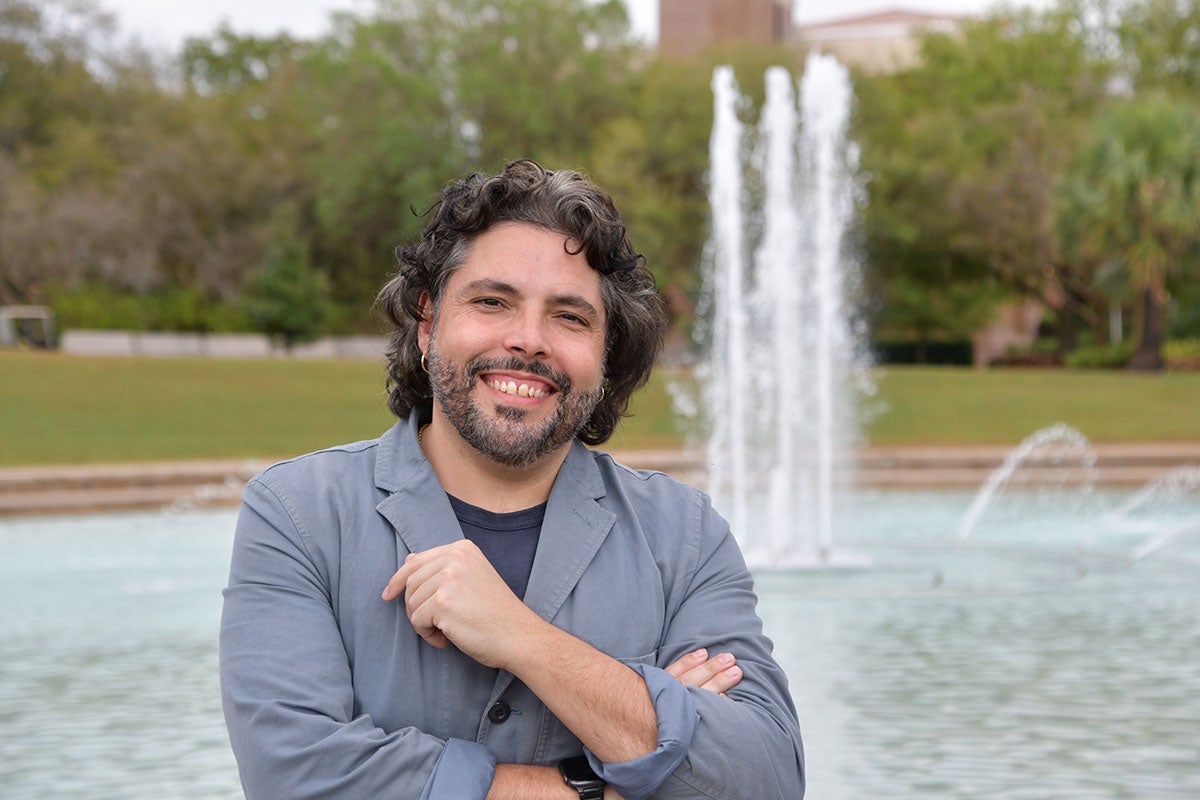The literary character Sherlock Holmes is best known for his uncanny ability to crack unsolvable cases through the power of observation and by making connections often missed by the average person.
Meet the microbiology world’s Sherlock Holmes – UCF Assistant Professor of Medicine Salvador Almagro-Moreno. His work in the field over the past 20 years and his ability to connect dots has resulted in pioneering work that’s helping map out the steps and triggers that lead to the emergence of potentially lethal pathogens.
His reputation resulted in the premier journal in microbiology, Trends in Microbiology, inviting him to write a perspective article about the emergence of pathogens, which published this spring.
Almagro-Moreno and his team carefully constructed a map of the various complicated connections and steps including a bacteria’s genetic connection to their environments that predispose certain ones to go rogue. He’s used Vibrio vulnificus, also known as flesh eating bacteria, and Vibrio cholerae, the agent of the diarrheal disease cholera, as his model systems. Not only is the UCF professor an excellent scientist, but he’s also a good communicator.
That’s why American Scientist magazine also asked him to write a piece explaining the connections and why understanding how pathogens evolve is important. The magazine is well respected among scientists, and they are the ones who write the articles, but they are geared for a general audience. The article is the cover piece of the magazine’s May/June edition available on newsstands now.
“This is very exciting,” he says. “It is complicated, but we are putting the puzzle pieces together. By using a holistic approach where we mixed ecology, computational biology, and molecular genetics we are figuring it out and I’m excited because now predicting emergence events is a possibility and that’s critical with the emergence of global pandemics like cholera and COVID-19. We need these tools to help manage disease outbreaks and address public health.”
His most recent scholarly paper was published in the Proceedings of the National Academy of Sciences, but his piece in American Scientist is much more accessible to the general public and explains the history of pathogens from the Black Plague to COVID-19 and why the recipe for triggering pathogens has been so elusive. It’s not just mainstream publications that ask for his help. He provides expert opinion to the Food and Drug Administration on flesh-eating bacteria and has been awarded a U.S. National Science Foundation Career Award grant.
“The process is really complicated,” he says with a smile. “It’s a culmination of a lot of different expertise. My lab has students and post-docs with a variety of skills. Together we are making progress. I’m super excited because now we have a clearer picture of how it all works.”
Bacteria can make leaps in evolution because of some unique traits that allow it to pick up and reproduce DNA material that may be floating in their environment. As that material changes, so does the bacteria. His field work in India and the United States, including work done in Brevard and Indian River counties in Florida indicate that there are ecological drivers that lead to the selection of pathogenic traits and virulent strains.
In the American Scientist, he explains.
“Clearly, a plethora of mechanisms and vehicles exist that allow bacteria to acquire new traits from the environment, helping them achieve the quantum leap that can lead to their emergence as pathogens. But evolution does not follow an intentional course, so the quantum leap can also take bacteria in the wrong direction: Acquiring foreign genetic fragments can cause substantial wreckage and disrupt an organism’s well-ingrained physiology. Identifying the environments and conditions that favor microbial risk-taking is an active area of research.”
Many of the clues fell into place when the professor and his team were doing work in the Indian River Lagoon in East Central Florida, and they discovered a new species of bacteria. On the surface it looked like the bacteria they have been studying for several years – V. vulnificus. But when they looked at it on the genetic level, they discovered it was not. The new species is Vibrio floridiensis. It is the closest known relative to the infamous flesh-eating bacterium, but it is not harmful.
“This new species is so close we almost missed it,” he says. “Once we took a close look some of the pieces fell into place.”
There’s still plenty to figure out, he says. But at least now the team has a map with landmarks for figuring out the process. Like Sherlock Holmes, he’s up for the challenge.
“It’s critical we keep moving forward putting the pieces together and making sure they fit,” he says. “We’re still pioneering. As the world changes, it is important to figure out the drivers because COVID is just the latest pathogen to get global attention because of the big impact it had on us. There is more to come, and we need the tools to help us get through it.”
Almagro-Moreno joined UCF in 2017 and established his lab, which focuses on the emergence and evolution of bacterial pathogens. He holds multiple degrees from universities in Spain and Ireland and completed his postdoctoral studies as the Ernest Everett Just Postdoctoral Fellow at Dartmouth College. He has published dozens of journal articles and his lab has received more than $1.2 million in grant funding. He was named a U.S. National Science Foundation CAREER award recipient. He also received the “Ramon y Cajal” award, the most prestigious award given by the Government of Spain to an early career scientist. He is a member of the National Center for Integrated Coastal Research and the Genomics and Bioinformatics cluster at UCF.




